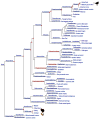Avian Cytogenomics: Small Chromosomes, Long Evolutionary History
- PMID: 41009947
- PMCID: PMC12470241
- DOI: 10.3390/genes16091001
Avian Cytogenomics: Small Chromosomes, Long Evolutionary History
Abstract
This review considers fundamental issues related to the genomics of birds (Aves), including the special organization and evolution of their chromosomes. In particular, we address the capabilities of molecular genetic/genomic approaches to clarify aspects of their evolutionary history, including how they have adapted to multiple habitats. We contemplate general genomic organization, including the small size and typical number of micro/macrochromosomes. We discuss recent genome sequencing efforts and how this relates to cytogenomic studies. We consider the emergence of this unique organization ~245 million years ago, examining examples where the "norm" is not followed. We address the functional role of synteny disruptions, centromere repositioning, repetitive elements, evolutionary breakpoints, synteny blocks and the role of the unique ZW sex chromosome system. By analyzing the cytogenetic maps and chromosomal rearrangements of eight species, the possibility of successfully applying modern genomic methods/technologies to identify general and specific features of genomic organization and an in-depth understanding of the fundamental patterns of the evolution of avian genomes are demonstrated. An interpretation of the observed genomic "variadicity" and specific chromosomal rearrangements is subsequently proposed. We also present a mathematical assessment of cross-species bacterial artificial chromosome (BAC) hybridization during genomic mapping in the white-throated sparrow, a species considered a key model of avian behavior. Building on model species (e.g., chicken), avian cytogenomics now encompasses hundreds of genomes across nearly all families, revealing remarkable genomic conservation with many dynamic aspects. Combining classical cytogenetics, high-throughput sequencing and emerging technologies provides increasingly detailed insights into the structure, function and evolutionary organization of these remarkable genomes.
Keywords: adaptation; avian genomes; birds (Aves); chromosomal rearrangements; chromosomes; cytogenomics; genome evolution; genome organization; genomic technologies; molecular genetic approaches.
Conflict of interest statement
The authors declare no conflicts of interest.
Figures






References
-
- Griffin D.K., Farré M., Lithgow P., O’Connor R., Romanov M.N., Larkin D. Avian chromonomics goes functional. Chromosome Res. 2015;23:367. doi: 10.1007/s10577-014-9447-3. - DOI
-
- Souza G.M., Vidal J.A.D., Utsunomia R., Deon G.A., de Oliveira E.H.C., Franca R.T., Porto-Foresti F., Liehr T., de Souza F.H.S., Kretschmer R., et al. Cytogenomic analysis in Seriemas (Cariamidae): Insights into an atypical avian karyotype. J. Hered. 2025;116:441–452. doi: 10.1093/jhered/esaf012. - DOI - PubMed
-
- Romanov M.N., Trukhina A.V., Smirnov A.F., Griffin D.K. Actual Problems of Cytogenomics, Organization and Evolution of the Genomes and Chromosomes in Birds. In: Pozyabin S.V., Kochish I.I., Romanov M.N., editors. Molecular Genetic Technologies for Analysis of Gene Expression Related to Animal Productivity and Disease Resistance; Proceedings of the 3rd International Scientific and Practical Conference, Moscow, Russia, 30 September 2021. Sel’skokhozyaistvennye Tekhnologii; Moscow, Russia: 2021. pp. 64–79. Ministry of Agriculture of the Russian Federation; Federal State Budgetary Educational Institution of Higher Education “Moscow State Academy of Veterinary Medicine and Biotechnology–MVA named after K.I. Scriabin”. - DOI
Publication types
MeSH terms
LinkOut - more resources
Full Text Sources

